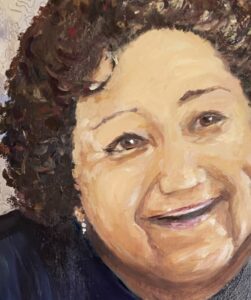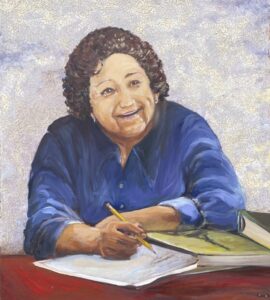Helen Bass Williams
32″ x 36″, oil
This was a phenomenal project, in every way. I am so honored and grateful that I was able to paint Professor Helen Bass Williams’ portrait.
She was the first Black faculty member at Purdue and she had a powerful impact on campus, est ablishing what is now called the Helen Bass Williams Learning Center. She also assisted with the establishment of the Purdue Black Cultural Center and helped create Purdue’s African American Studies program.
ablishing what is now called the Helen Bass Williams Learning Center. She also assisted with the establishment of the Purdue Black Cultural Center and helped create Purdue’s African American Studies program.
This followed a lengthy career in Mississippi where she established and ran Head Start programs and taught at two different colleges. She also participated in many Civil Rights protests and voter education. Perhaps her greatest gifts were the supportive relationships she established with so many college students.
This painting brings together many different elements. Professor Williams is firm and unyielding, and also feminine and graceful. The vibrant, dynamic blue of her blouse is set against a red desk because there was a lot of tension to the work she did.
And the books on her desk are green. Green is symbolic of growth and nurturing.
Her desk is a little bit chaotic, and that came straight from a photograph in the Purdue archives. It’s a casual picture of her at home, playing with her dog, and in the background you can see there’s a big pile of manuscripts and paperwork. So many projects.
I’d gone to the Purdue archives in search of a photo of Professor Williams and her library.
It seems like academic portraits often have people in their offices with their bookshelves in the background. The photo I’d started with just had a blank wall behind her.
Well in Professor Williams’ personal collection of photos, there weren’t any photos of her in her library.
The photographs that she had gathered and kept were all pictures of people. So many children. Kids playing and learning and eating. Teachers and friends. Political activists. Purdue students.
I wanted to include them in her portrait, but not like a busy collage.
So I took a couple of photos that I’d digitized and I traced them, reducing people to just the lines of their silhouettes. One is a photo of her holding a child’s hand. Another is a picture of her speaking to Purdue students at a rally in front of University Hall.
But even those lines were still too literal and distracting.
So I put a layer of heavy paint in the background of her painting and I started carving the lines themselves. Just the curves and motion and connections.
As the piece continued, the wall itself started to dissolve a little, become one with the larger world outside.
Then I ran into a challenge as I was gathering information about Professor Williams.
I read a lot of articles about her as I searched for photographs. She encountered violence as she protested. Terrible things happened. For example, I read that when Professor Williams was marching for voting rights, for access to the ballot box, she learned to carry a little meat in her pockets. She’d coat her fingers with the meat so that when the police dogs were turned on her, they would lick her fingers. Instead of biting her.
How do we deal with that?
There’s a lot of pressure right now to avoid talking about American history – should we be silent, here?
I didn’t know.
So I went to Briggitta August of Purdue for guidance. Briggitta thought about it and came back and said no, Helen wouldn’t want the violence that was done to her memorialized in her portrait.
And Briggitta urged me to look for Professor Williams’ “internal narrative and perspective of self”.
I loved that.
And yeah – I’d found photographs of her….and articles…and I’d listened to her voice on recordings from the archives. But I still didn’t have her internal narrative.
It’s interesting, because that’s something people reveal when they sit for portraits, even quick sketches. You can see it in how they hold themselves, how they choose to occupy space.
So – I remembered that in 2004 Mary O’Hara’s 2004 wrote her doctoral dissertation about Helen Bass Williams. It’s called “Let It Fly”. I learned of its existence at the dedication of the Helen Bass Williams Learning Center last August.
But I didn’t go searching for the dissertation initially because I knew it wouldn’t have any photographs. In fact, I assumed it would just be a bunch of graphs and charts and numbers – I’d typed my ex-husband’s dissertation, way back in the day. Phanerochaete Chrosysporium, omg, so much fungus.
But this dissertation, by Dr. O’Hara, it’s full of Helen’s stories.
People had said she was a masterful storyteller. Wow, she kept me engaged. Her stories are powerful and beautiful and nuanced, and sometimes tragic.
Her voice, though.
In her stories I could see her world, and I could hear her voice. And I knew how she created her internal narrative and perspective of self. Because she’s right there in the telling.
What Professor Williams said is:
“It’s in my heart that as long as I can reach down and find some love and real respect and regard for someone else other than myself and pull it out and pass it on to someone else, then I think my living has not been in vain. If I can do that, always then I think I’m able to face the next day.”
Thank you to Briggitta August and Jen William for bringing me on board and providing guidance and enthusiasm. Thank you to Helen’s friends, Betty Zamora and Betty Nelson, for giving me your valuable insights. Thanks to my dear friends and to my mother, for your support.


